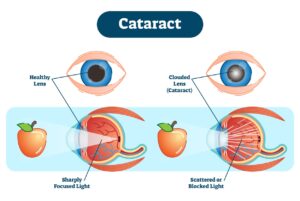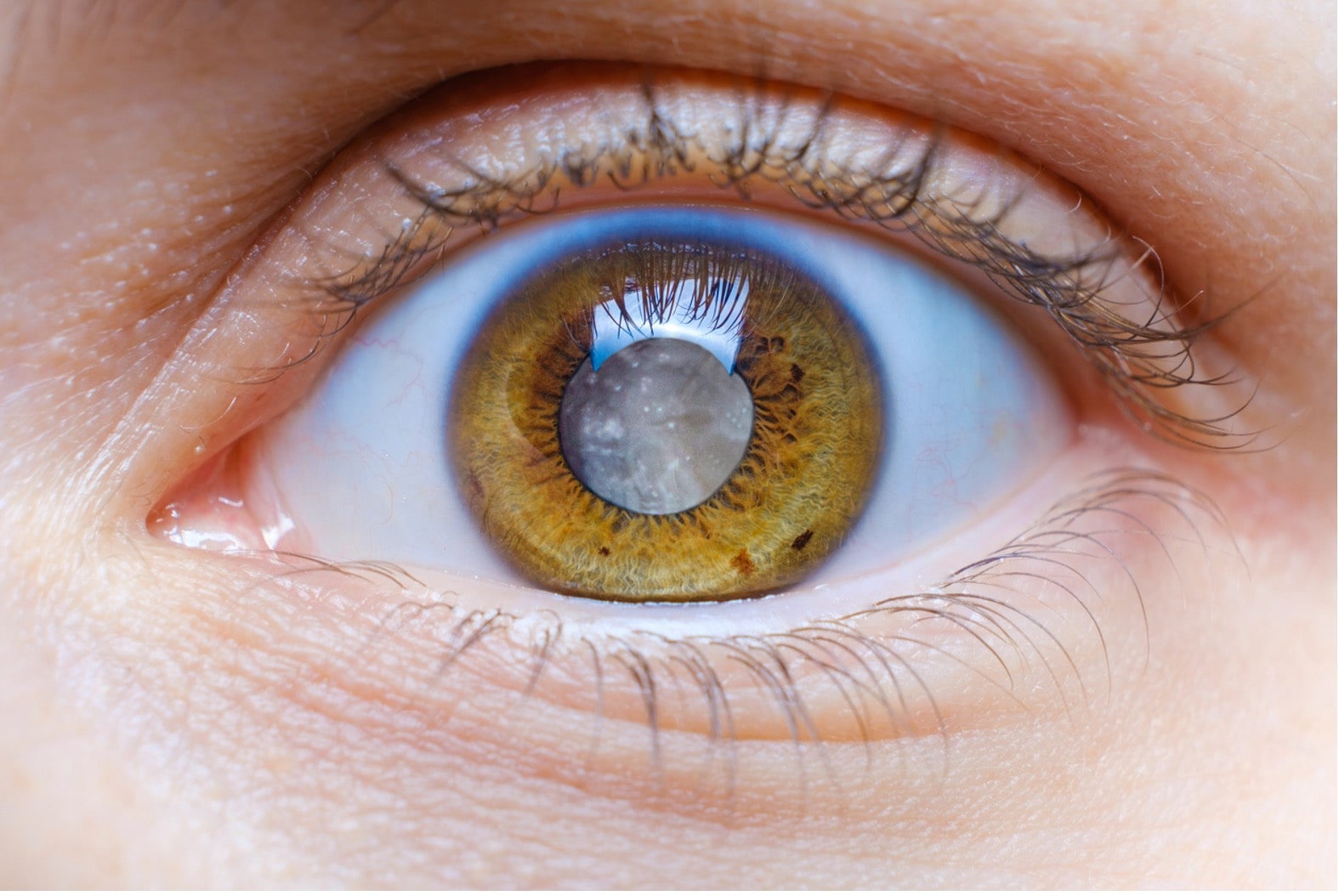Cataracts are a prevalent eye condition associated with aging that have a substantial impact on one’s vision. In this blog, we will explore the causes, symptoms, and various treatment options available for cataracts.
What are Cataracts?
Cataracts occur when the lens of the eye, which is normally clear and transparent, becomes cloudy or opaque. This clouding prevents light from passing through the lens properly, leading to blurry or distorted vision. The lens plays a crucial role in focusing light onto the retina, where images are formed and transmitted to the brain. When cataracts develop, the quality of the images reaching the retina is compromised, resulting in vision impairment.
Causes of Cataracts
The primary cause of cataracts is the natural aging process. As we grow older, the proteins in our lenses can clump together, forming cloudy areas.
Other factors that can contribute to cataract development include:
- Family History: A family history of cataracts may suggest a genetic predisposition to the condition.
- Medical Conditions: Certain medical conditions, such as diabetes, can increase the risk of developing cataracts.
- Ocular Injuries and Surgical Procedures: Trauma to the eye or previous eye surgeries can increase the likelihood of cataract formation.
- Prolonged Exposure to Sunlight: Ultraviolet (UV) radiation from the sun can damage the lens over time, leading to cataracts.
- Excessive Smoking and Alcohol Consumption: Engaging in these lifestyle behaviors has been associated with a higher risk of cataract development.
- Use of Certain Medications: Long-term use of medications like corticosteroids can accelerate cataract formation.
It’s important to note that while these factors can increase the risk of developing cataracts, they do not guarantee the development of the condition. Cataracts can also occur in individuals with no identifiable risk factors.
Symptoms of Cataracts
In the early stages, cataracts may not cause noticeable symptoms. However, as the condition progresses, the following symptoms may become apparent:
- Blurred Vision: Objects may appear hazy or out of focus, making it difficult to see clearly.
- Reduced Color Perception: Colors may appear faded or less vibrant.
- Sensitivity to Light: Intense lighting can lead to glare and discomfort, particularly during nighttime or in strong sunlight.
- Difficulty Seeing at Night: Vision may be impaired in low-light conditions, making it challenging to navigate and drive safely.
- Seeing Halos: Light sources may appear surrounded by halos or rings.
- Double Vision: Images may appear duplicated or overlapping, particularly in one eye.
If you experience any of these symptoms, it is essential to consult an eye care professional for a comprehensive eye examination and accurate diagnosis.

Diagnosis of Cataracts
A thorough eye examination is necessary to diagnose cataracts accurately. During the examination, an ophthalmologist will perform various tests to assess the clarity of your vision and the health of your eyes.
These tests may include:
- Visual Acuity Test: This test measures how well you can see at different distances using an eye chart.
- Slit-lamp Examination: The ophthalmologist uses a specialized microscope to examine the structures of your eye, including the lens, cornea, and iris.
- Dilated Eye Examination: This dilation process allows the ophthalmologist to detect the presence, size, and location of any forming cataracts.
- Contrast Sensitivity Test: This test evaluates your ability to distinguish between different shades of gray, which can be affected by cataracts.
- Glare Test: By measuring your sensitivity to glare, the ophthalmologist can assess how cataracts are impacting your vision in bright light conditions.
Based on the results of these tests, your ophthalmologist will determine the existence and severity of cataracts and recommend an appropriate treatment plan.
Treatment Options for Cataracts
While there are currently no medications or alternative methods proven to reverse or prevent cataracts, there are effective treatment options available, primarily surgical intervention. Cataract surgery involves removing the cloudy lens and replacing it with an artificial intraocular lens (IOL). This procedure is typically safe and known for its high success rate in restoring clear vision.
Cataract Surgery
Cataract surgery is one of the most commonly performed surgeries worldwide. During the procedure, your ophthalmologist will make a small incision in the eye and use advanced techniques to break up the cloudy lens and remove it. The artificial IOL is then inserted, restoring clear vision.
Two of the most common surgical techniques used for cataract removal include:
- Phacoemulsification: This technique involves using ultrasound energy to break up the cloudy lens into tiny fragments, which are then removed through a small incision. Phacoemulsification is the most common and preferred method due to its quicker recovery time and minimal risk of complications.
- Extracapsular Cataract Extraction: In this scenario, a larger incision is made to remove the cloudy lens in one piece. This method may be used in certain instances where phacoemulsification is not suitable.
Your ophthalmologist will determine the most appropriate surgical technique based on the specifics of your cataract and your overall eye health.
Lens Options
During cataract surgery, you have the opportunity to choose the type of intraocular lens (IOL) that will replace your cloudy lens. There are various types of IOLs available, each offering different advantages and considerations:
- Monofocal IOLs: These lenses provide clear vision at a single fixed distance, typically for either near, intermediate, or distance vision. Patients with monofocal IOLs may still require glasses for certain activities.
- Multifocal IOLs: These lenses offer multiple focal points, allowing for clear vision at different distances. Multifocal IOLs can reduce the need for glasses after surgery but may cause some visual side effects, such as halos or glare.
- Toric IOLs: These lenses are designed to correct astigmatism, a common refractive error. Toric IOLs can address both cataracts and astigmatism, reducing the need for additional corrective procedures or glasses.
- Accommodating IOLs: These lenses are designed to mimic the natural focusing ability of the eye, allowing for a range of clear vision without relying on glasses. Accommodating IOLs offers enhanced depth of focus.
Your ophthalmologist will discuss the available lens options and help you choose the lens that aligns best with your visual needs and lifestyle.
Preventive Measures for Cataracts
While it is not possible to completely prevent the development of cataracts, certain measures can help slow their progression and maintain overall eye health. Consider the following preventive strategies:
- Protect Your Eyes from UV Radiation: Wear sunglasses that block 100% of Ultraviolet A (UVA) and Ultraviolet B (UVB) rays when outdoors. Additionally, wear a wide-brimmed hat to provide additional shade and protection.
- Consider Quitting Smoking: Smoking has been linked to an increased risk of cataract development. Quitting smoking can help lower this risk and contribute to better overall health.
- Maintain a Healthy Lifestyle: Eat a balanced diet rich in fruits, vegetables, and whole grains. Regular exercise and adequate hydration are necessary for maintaining optimal eye health.
- Control Underlying Health Conditions: Properly manage chronic health conditions such as diabetes and hypertension, as these can contribute to cataract development.
- Attend Regular Eye Exams: Routine eye examinations allow for the early detection of cataracts and other eye ailments, allowing for prompt intervention and treatment.
Contact Us
Cataracts can have a profound impact on your vision. Understanding the causes, symptoms, and treatment options for cataracts is crucial for maintaining optimal eye health. If you are experiencing any symptoms or have concerns about cataracts, it is essential to consult an eye care professional for a thorough examination and personalized treatment plan.
At Florida Eye, our experienced team is here to provide you with expert care and guidance. Remember, early detection and appropriate intervention can help preserve your vision!



